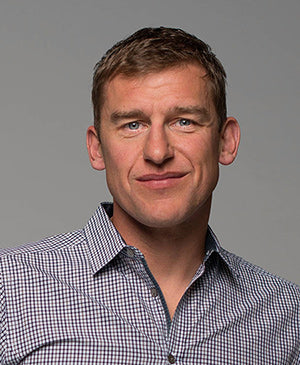By Matt Dixon, coach and founder of Purple Patch Fitness
Whenever we broach the subject of strength training for endurance athletes it can quickly elicit evangelical reactions for those on both sides of the argument. I hear some endurance coaches proclaim that there is no value of training outside of the specific demands of the sport; while a CrossFitter will proclaim that endurance activity is grossly overrated and the real resilience and endurance comes from having strength as the centerpiece of any training regime.
As we explore, I should disclose that I strongly believe that potential and performance will only meet for an endurance athlete when a consistent, critical supplement of strength and conditioning is part of the training program. However, rather than simply pontificating about my opinion, let’s explore the lens I take on strength and conditioning via a case study of a real Purple Patch athlete.

Athlete Case Study: Meet Jenny
Jenny is a 46-year-old long-time endurance athlete. She is accomplished as an age grouper and over her career has often finished on the podium. She clearly has a highly developed cardiovascular system as she has been doing the sport for so many years. She is one fit woman.
Despite this, a couple of years ago, Jenny plateaued. Her performances were stagnant, and this led to an erosion in confidence in both her ability as an athlete, but also herself as a human. Triathlon was her identification in many ways, and the flat performances left her feeling flat as a person. Not a great place to be.
Her antidote to this situation was to throw more effort at her training. She trained more and more hours, amped up her riding and running miles, and aimed to develop more and more resilience and fitness. She needed more to get more, despite her years in the sport. To further support her cause, she decided to head to a performance lab for physiological testing, and out of that single session the well-meaning physiologist prescribed some magic training zones and told her to keep working hard and to continue to develop the base.
Jenny came to Purple Patch with prescription in hand and a readiness to add to the piles of miles. It was time to break the plateau.
I looked at the history and the lab results, then almost spilt my morning coffee when reading the advice. Building the base and working more was only going to result in one thing. She would keep developing fitness, but would slowly choose lower and lower gears on each hill, getting slower and slower as the years and age continued to climb. It would be a route to getting slower; not the result we all wanted.

The key with Jenny was to realize that her baseline fitness was never the limiter, and she simply could not expect to get fitter and fitter. She required a radical shift in thinking and a complete refresh in her approach and route for what it would take to get faster.
The global intervention I ended up prescribing included:
- A complete strength and conditioning program.
- A reduction in total training hours.
- Strength-based riding repetitions (low cadence) and hill-based riding and running.
- Increase global intensity of intervals to balance the lower overall training duration.
This prescription was outlined with a couple of things in mind. First, she required a change of stimulus and a shift in training approach. And since I was also cognizant of her health and development as a women, these factors played a role in the intervention too.
While she was fit, she was approaching the years of hormonal transition, and with upcoming menopause it was critical to introduce strength as a stimulus to prevent a plummeting bone density status and global health decline. I wanted to define a woman who was strong, as a platform of health and performance, and who could then build triathlon performance on top of the platform.
So, what were the results? Over an 18-month period she not only evolved, but progressed to a whole new level. She began hitting performances faster than from five to seven years prior. Strength training played a critical role in these performance gains, but not just in the way that you may think. I feel like it truly helped Jenny in ways beyond the splits of swim, bike and run.

Confidence
Shifting the lens from simply developing miles in training allowed a fresh lens, and also an arena in which Jenny could develop and — yes — improve. When we improve, we smile, and the feelings of growth and development replaced stagnation with joy. It was important to build success, and this was an easy win.
Beyond this, Jenny felt better. The improvement in posture, standing taller and more proud, was highly noticeable. She lost no real weight, but kept getting compliments on how good she looked. I realize vanity has no place in a performance article, but it added to the feeling of being an inch taller. It aided confidence.
Range of Training
The athletic awareness, motor control and stability had a large impact in her approach to the endurance training. The prior Jenny simply relied on accumulating hours and miles, but strength aided in a shift in athletic awareness.
She had improved musculoskeletal health, but also a realization that the key low cadence work could be attacked with confidence and an area of development. She began chasing output over miles, and the shift in mindset was born out of the strength work completed. Another benefit, she quickly linked the strength to what we were looking to accomplish in the critical endurance work, and this allowed her to maximize the yield from these areas.
The key — for Jenny and for you — is that adding strength training into your endurance routine is never going to be the route to improvement, but instead is a critical performance partner on that journey. Let’s dive into the why.

Positioning Strength
As I have mentioned in previous discussions around performance, strength is simply one part of the performance puzzle. As a high performance or endurance enthusiast a simple fact remains:
When you have an appropriate endurance training program, supported with strength training a platform of quality nutrition and adequate recovery and sleep, you accelerate. No matter your level, it happens every time.
So, we remove the other elements in the performance puzzle and only consider strength. This is why I call it a performance partner. A catalyst to help improvements in the bullseye - your endurance training.
Appropriate integrated strength will:
- Have a hand in avoiding injury
- Act as a bridge between mobility, balance, synchronization and strength with the sport specific endurance
- Create a platform to maximize the hard work of sport-specific (that’s endurance) training.

To allow us to keep this crisp, let’s just outline the important things to consider as you map your own approach to strength and conditioning:
-
It doesn’t need to dominate the training schedule to be effective. This is critical as most endurance athletes are time-starved, and who has time to head to the gym for 60- to 90-minutes two to three times a week? Short sessions that are easily integrated are highly effective and important.
-
It must be a season-long and year-round endeavor. While the purpose, role and personality of your strength sessions may evolve as the year progresses, to be effective it cannot simply be an off-season activity. Integrate as a part of your performance journey, always.
-
It must be about building an athlete - not an endurance athlete. Go beyond picking sport-specific movements, as you already have sport-specific movements under load by running, riding up hills, etc. Think about supportive, lateral and a 360-degree focus in strength. Become athletic — then use your endurance training to amplify and prepare for the sport you are doing.
-
Just because you do strength doesn’t mean you will add power or pace, and doesn’t promise injury avoidance. The puzzle is broader than this. You should never view the positive role of strength in a silo. Retain a big picture lens.
-
“Join the dots” between the gym (strength work) and what you are doing in sport specific training. For the real benefit and value, it is important that strength training not live in a vacuum only to be forgotten when riding uphill or getting fatigued in running.

WHY Integrated Strength
(notice that word integrated - we will come back to that!)
The benefits of a properly designed functional strength program can unlock your potential to improve as an athlete and include:
- Increased movement synchronization & coordination.
- Developmental platform for biomechanics & form.
- Improved athleticism.
- Enhanced injury prevention.
That list should wow you - improvement in those four areas will have a dramatic impact on your performance as an endurance athlete. In case that list is too abstract or technical, let me break down the benefits for you in different terms:
- Improved muscle recruitment throughout the entire range of motion of the movement: all your muscles working together in balance, instead of stronger muscles compensating for weaker ones.
- Ability to generate a given power output with less effort.
- Allow you to move more efficiently - swim, bike and run more smoothly.
- Allow you to increase your power production threshold.
- Staying healthy unlocks the holy grail of endurance sports: being able to train consistently over many months, without having to take time off for injury recovery.

I hope with that list you are suitably engaged in the value and role of strength. When properly mapped and integrated it will not only bring you joy and a shift in training lens, it will also serve to amplify the endurance training you do.
That is why we never view its role as simply aiming to prevent the negative of injury, and truly see it as a part of your performance journey.

Matt Dixon is a world-class triathlon coach, former professional triathlete, elite swimmer and exercise physiologist. His Purple Patch coaching community is based in San Francisco, but his athletes span the globe.
His professional triathlon squad has amassed more than 300 Professional wins and podiums in IRONMAN and IRONMAN 70.3 races, including the 2016 World Champion. He has qualified more than 250 athletes to the Hawaii IRONMAN World Championships, with multiple Age Group World Champions, but he is equally known for his groundbreaking work successfully creating performance in sport and life for time-starved individuals. He guides many leading CEOs of major companies, including well known tech industry leaders.
Matt is the author of the Well Built Triathlete, as well as the new Fast Track Triathlete, an IRONMAN U Master coach, global hydration advisor for Camelbak and a much sought performance expert and speaker.
